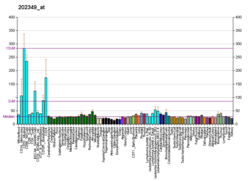Torsin-1A (TorA) also known as dystonia 1 protein (DYT1) is a protein that in humans is encoded by the TOR1A gene (also known as DQ2 or DYT1). TorA localizes to the endoplasmic reticulum and contiguous perinuclear space, where its ATPase activity is activated by either LULL1 or LAP1, respectively.
Function
The protein encoded by this gene is a member of the AAA family of adenosine triphosphatases (ATPases), is related to the Clp protease/heat shock family.
Clinical significance
Mutations in this gene result in the autosomal dominant disorder, torsion dystonia 1.
References
- ^ GRCh38: Ensembl release 89: ENSG00000136827 – Ensembl, May 2017
- ^ GRCm38: Ensembl release 89: ENSMUSG00000026849 – Ensembl, May 2017
- "Human PubMed Reference:". National Center for Biotechnology Information, U.S. National Library of Medicine.
- "Mouse PubMed Reference:". National Center for Biotechnology Information, U.S. National Library of Medicine.
- Ozelius LJ, Page CE, Klein C, Hewett JW, Mineta M, Leung J, Shalish C, Bressman SB, de Leon D, Brin MF, Fahn S, Corey DP, Breakefield XO (Mar 2000). "The TOR1A (DYT1) gene family and its role in early onset torsion dystonia". Genomics. 62 (3): 377–84. doi:10.1006/geno.1999.6039. PMID 10644435.
- ^ "Entrez Gene: TOR1A torsin family 1, member A (torsin A)".
Further reading
- Ozelius LJ, Hewett JW, Page CE, et al. (1998). "The gene (DYT1) for early-onset torsion dystonia encodes a novel protein related to the Clp protease/heat shock family". Advances in Neurology. 78: 93–105. PMID 9750906.
- Ferrari Toninelli G, Spano P, Memo M (2003). "TorsinA, microtubules and cell polarity". Funct. Neurol. 18 (1): 7–10. PMID 12760408.
- Rothwell JC, Edwards M, Huang YZ, Bhatia KP (2004). "Physiological studies in carriers of the DYT1 gene mutation". Rev. Neurol. (Paris). 159 (10 Pt 1): 880–4. PMID 14615676.
- Ozelius LJ, Hewett JW, Page CE, et al. (1997). "The early-onset torsion dystonia gene (DYT1) encodes an ATP-binding protein". Nat. Genet. 17 (1): 40–8. doi:10.1038/ng0997-40. PMID 9288096. S2CID 29095964.
- Augood SJ, Penney JB, Friberg IK, et al. (1998). "Expression of the early-onset torsion dystonia gene (DYT1) in human brain". Ann. Neurol. 43 (5): 669–73. doi:10.1002/ana.410430518. PMID 9585364. S2CID 30238231.
- Kamm C, Castelon-Konkiewitz E, Naumann M, et al. (1999). "GAG deletion in the DYT1 gene in early limb-onset idiopathic torsion dystonia in Germany". Mov. Disord. 14 (4): 681–3. doi:10.1002/1531-8257(199907)14:4<681::AID-MDS1020>3.0.CO;2-M. PMID 10435508. S2CID 20194006.
- Ikeuchi T, Shimohata T, Nakano R, et al. (1999). "A case of primary torsion dystonia in Japan with the 3-bp (GAG) deletion in the DYT1 gene with a unique clinical presentation". Neurogenetics. 2 (3): 189–90. doi:10.1007/s100480050082. PMID 10541594. S2CID 27834129.
- Shashidharan P, Kramer BC, Walker RH, et al. (2000). "Immunohistochemical localization and distribution of torsinA in normal human and rat brain". Brain Res. 853 (2): 197–206. doi:10.1016/S0006-8993(99)02232-5. PMID 10640617. S2CID 7112316.
- Hewett J, Gonzalez-Agosti C, Slater D, et al. (2000). "Mutant torsinA, responsible for early-onset torsion dystonia, forms membrane inclusions in cultured neural cells". Hum. Mol. Genet. 9 (9): 1403–13. doi:10.1093/hmg/9.9.1403. PMID 10814722.
- Kustedjo K, Bracey MH, Cravatt BF (2000). "Torsin A and its torsion dystonia-associated mutant forms are lumenal glycoproteins that exhibit distinct subcellular localizations". J. Biol. Chem. 275 (36): 27933–9. doi:10.1074/jbc.M910025199. PMID 10871631.
- Suzuki Y, Tsunoda T, Sese J, et al. (2001). "Identification and characterization of the potential promoter regions of 1031 kinds of human genes". Genome Res. 11 (5): 677–84. doi:10.1101/gr.gr-1640r. PMC 311086. PMID 11337467.
- Konakova M, Huynh DP, Yong W, Pulst SM (2001). "Cellular distribution of torsin A and torsin B in normal human brain". Arch. Neurol. 58 (6): 921–7. doi:10.1001/archneur.58.6.921. PMID 11405807.
- Sharma N, Hewett J, Ozelius LJ, et al. (2001). "A close association of torsinA and alpha-synuclein in Lewy bodies: a fluorescence resonance energy transfer study". Am. J. Pathol. 159 (1): 339–44. doi:10.1016/s0002-9440(10)61700-2. PMC 1850427. PMID 11438481.
- Leung JC, Klein C, Friedman J, et al. (2002). "Novel mutation in the TOR1A (DYT1) gene in atypical early onset dystonia and polymorphisms in dystonia and early onset parkinsonism". Neurogenetics. 3 (3): 133–43. doi:10.1007/s100480100111. PMID 11523564. S2CID 11713438.
- Tuffery-Giraud S, Cavalier L, Roubertie A, et al. (2002). "No evidence of allelic heterogeneity in the DYT1 gene of European patients with early onset torsion dystonia". J. Med. Genet. 38 (10): 35e–35. doi:10.1136/jmg.38.10.e35. PMC 1734733. PMID 11584049.
- Major T, Svetel M, Romac S, Kostić VS (2002). "DYT1 mutation in primary torsion dystonia in a Serbian population". J. Neurol. 248 (11): 940–3. doi:10.1007/s004150170045. PMID 11757956. S2CID 10128440.
- Walker RH, Morgello S, Davidoff-Feldman B, et al. (2002). "Autosomal dominant chorea-acanthocytosis with polyglutamine-containing neuronal inclusions". Neurology. 58 (7): 1031–7. doi:10.1212/wnl.58.7.1031. PMID 11940688. S2CID 38388934.
- Hjermind LE, Werdelin LM, Sørensen SA (2002). "Inherited and de novo mutations in sporadic cases of DYT1-dystonia". Eur. J. Hum. Genet. 10 (3): 213–6. doi:10.1038/sj.ejhg.5200782. PMID 11973627.
External links
This article incorporates text from the United States National Library of Medicine, which is in the public domain.
This article on a gene on human chromosome 9 is a stub. You can help Misplaced Pages by expanding it. |





